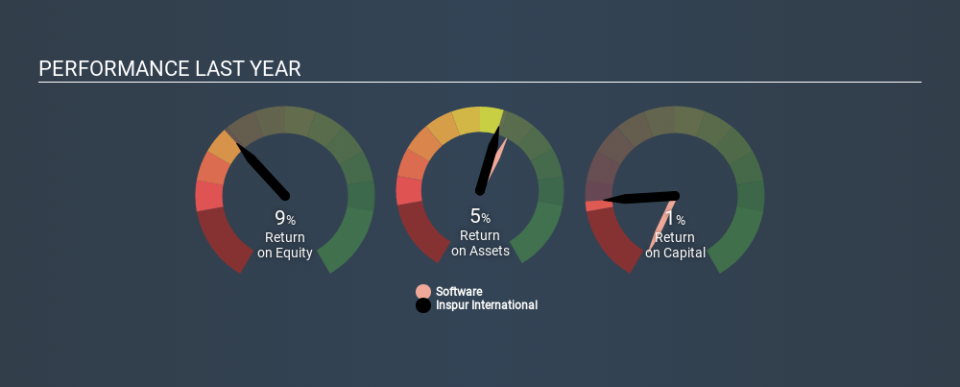Shareholders Should Look Hard At Inspur International Limited’s (HKG:596) 0.8%Return On Capital

Today we'll evaluate Inspur International Limited (HKG:596) to determine whether it could have potential as an investment idea. Specifically, we'll consider its Return On Capital Employed (ROCE), since that will give us an insight into how efficiently the business can generate profits from the capital it requires.
First of all, we'll work out how to calculate ROCE. Then we'll compare its ROCE to similar companies. And finally, we'll look at how its current liabilities are impacting its ROCE.
Understanding Return On Capital Employed (ROCE)
ROCE measures the amount of pre-tax profits a company can generate from the capital employed in its business. In general, businesses with a higher ROCE are usually better quality. Ultimately, it is a useful but imperfect metric. Renowned investment researcher Michael Mauboussin has suggested that a high ROCE can indicate that 'one dollar invested in the company generates value of more than one dollar'.
How Do You Calculate Return On Capital Employed?
The formula for calculating the return on capital employed is:
Return on Capital Employed = Earnings Before Interest and Tax (EBIT) ÷ (Total Assets - Current Liabilities)
Or for Inspur International:
0.0078 = HK$19m ÷ (HK$4.1b - HK$1.7b) (Based on the trailing twelve months to December 2019.)
Therefore, Inspur International has an ROCE of 0.8%.
See our latest analysis for Inspur International
Does Inspur International Have A Good ROCE?
ROCE can be useful when making comparisons, such as between similar companies. We can see Inspur International's ROCE is meaningfully below the Software industry average of 6.5%. This performance could be negative if sustained, as it suggests the business may underperform its industry. Regardless of how Inspur International stacks up against its industry, its ROCE in absolute terms is quite low (especially compared to a bank account). There are potentially more appealing investments elsewhere.
Inspur International has an ROCE of 0.8%, but it didn't have an ROCE 3 years ago, since it was unprofitable. That suggests the business has returned to profitability. The image below shows how Inspur International's ROCE compares to its industry, and you can click it to see more detail on its past growth.
Remember that this metric is backwards looking - it shows what has happened in the past, and does not accurately predict the future. ROCE can be deceptive for cyclical businesses, as returns can look incredible in boom times, and terribly low in downturns. ROCE is only a point-in-time measure. Since the future is so important for investors, you should check out our free report on analyst forecasts for Inspur International.
Do Inspur International's Current Liabilities Skew Its ROCE?
Liabilities, such as supplier bills and bank overdrafts, are referred to as current liabilities if they need to be paid within 12 months. The ROCE equation subtracts current liabilities from capital employed, so a company with a lot of current liabilities appears to have less capital employed, and a higher ROCE than otherwise. To counteract this, we check if a company has high current liabilities, relative to its total assets.
Inspur International has total assets of HK$4.1b and current liabilities of HK$1.7b. As a result, its current liabilities are equal to approximately 42% of its total assets. In light of sufficient current liabilities to noticeably boost the ROCE, Inspur International's ROCE is concerning.
Our Take On Inspur International's ROCE
There are likely better investments out there. You might be able to find a better investment than Inspur International. If you want a selection of possible winners, check out this free list of interesting companies that trade on a P/E below 20 (but have proven they can grow earnings).
I will like Inspur International better if I see some big insider buys. While we wait, check out this free list of growing companies with considerable, recent, insider buying.
If you spot an error that warrants correction, please contact the editor at editorial-team@simplywallst.com. This article by Simply Wall St is general in nature. It does not constitute a recommendation to buy or sell any stock, and does not take account of your objectives, or your financial situation. Simply Wall St has no position in the stocks mentioned.
We aim to bring you long-term focused research analysis driven by fundamental data. Note that our analysis may not factor in the latest price-sensitive company announcements or qualitative material. Thank you for reading.



